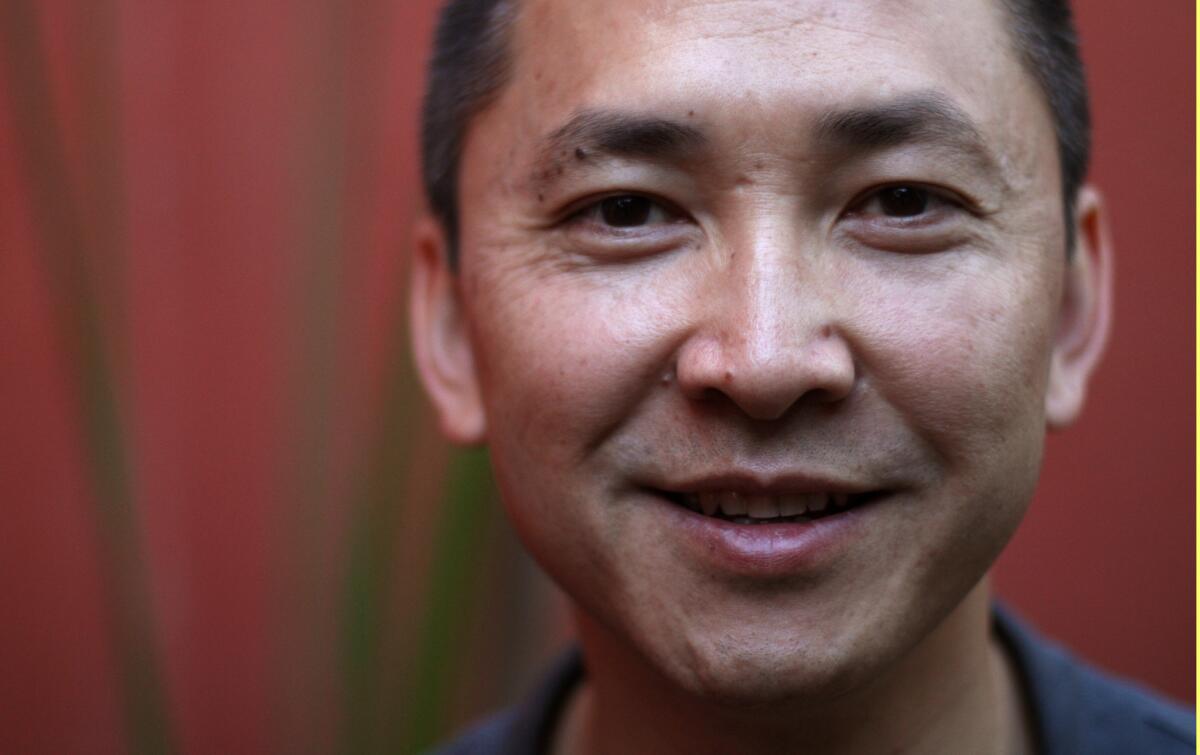Essay: A writer’s solitude vs. AWP: Viet Thanh Nguyen on what we share with others

Viet Thanh Nguyen, author of “The Sympathizer,” a book about defectors to America from Vietnam during the Vietnam War.
Writers tend to be solitary creatures, and yet more than 12,000 will congregate in Los Angeles this week. The occasion is the annual conference of the Assn. of Writers and Writing Programs, or AWP, which also draws other literary kin, the teachers, editors, publishers, critics and booksellers who together make up the literary industry. Being surrounded by more than 12,000 people of the same persuasion feels overwhelming rather than affirming to me, particularly because what I and many other writers do best is to be alone, the most essential condition for writing.
The book a reader consumes in a dozen hours has cost the writer hundreds and perhaps thousands of hours, time spent alone in the company of one’s mind (except when distracted by the virtual reality of social media). A conference like AWP pushes the writer and her work out into the public, albeit a sympathetic, literary one. Such an encounter raises the question of audience. For whom does the solitary writer write?
During the decade of misery that I spent writing short stories, the anxiety of writing for others often struck me. I wondered if editors would accept my stories, if agents would contact me, if juries would bestow a prize, if famous writers would hail my words. For all that writing involved excavating ideas, feelings, images and insights from a depthless cave within myself, I could not shake the sense that the literary industry’s judgment was as important as my own creative choices. AWP is the logical product of this literary industry, born into existence for the same reason that carmakers and pharmaceutical manufacturers gather together: to share the hottest products and trends, to form new networks and renew old bonds, and, most importantly, to affirm a shared identity and conviction. The distinction for writers is that their solitary trade and calling is at odds with the human need to gather in tribes.
Except that the story, the poem, or the image created by the writer can be the fire around which the tribe gathers.
If the industry is the business of publishing and the increasingly corporate university world of the MFA, the tribe symbolizes the human community that existed before capitalism and hopefully will exist after it. All writers need the tribe of readers, and many may need the industry. But some, like myself, also need to separate from both, at least for a while.

Author Viet Thanh Nguyen on the patio at his home.
I learned how to do so when working on a novel and after struggling with short stories. The constant reworking of sentence and narrative through writing short stories was my version of rubbing two sticks together. Suddenly, at a decade’s culmination, the fire started, and I could write with greater conviction and concentration than I had thought possible.
I finished “The Sympathizer” in two years, three months, having finally silenced, almost completely, the demands of others.
The only disruptions came when I spoke to my agent, who supportive as he was, was also a part of the literary industry. After speaking to him, I worried about whether my novel would sell, whether anyone would read or understand something seemingly so idiosyncratic. Then I turned off the worries, turned back to the page, and recommitted to what was essential: writing for myself.
Claiming that one writes for oneself is not usually what the literary industry wants to hear. Ideally, one should write for millions, although in the contemporary book sales climate, tens of thousands is more than enough. Even smaller numbers will suffice for the literary writer: thousands, hundreds, dozens, perhaps even just one other with whom the author can commune.
The scale of the audience bears no testimony to the worth of the work. Most bestselling books will crumble to dust along with their authors, while important, enduring writers often wrote and continue to write for the so-called small magazines, or for minuscule audiences interested in the experimental, the obscure, the subversive, and the minority.
As for myself, I can hardly deny desiring an audience after I finished my journey into solitude and returned to the world. I needed my agent to like the novel, and I yearned for an editor to buy it. Then I wanted the reviewers, and the librarians, and the teachers, and the bloggers, and the scholars. What the avant-garde writer Theresa Hak Kyung Cha called the dream of the audience remains, even for someone as fierce and fearless as she was. This dream is vanity, lust and frailty. This dream is also the belief that whatever a writer discovers in her depthless cave is something she can share with others, whether the discovery be beautiful or monstrous. The dream of an audience is, in short, part of what makes us human in weakness and in strength, and it will be all too present at this conference of thousands of literary dreamers.
Within each of those dreamers remains that other desire to write only for oneself. If my novel found an audience, it was only because I wrote for no one but myself (even as others indelibly shaped who I am). But while I needed to be alone to write for myself, I found after publishing that I was not as strange in my solitude as I thought. There were readers who thought and felt as I did, even as readers existed who cared not for my creation. This is what it means to be out in the world. It involves both renewing human relationships and realizing that one cannot, and probably should not, be liked by everyone.
After the bright lights of the convention center and the conference room, after the bonhomie and the darting glances at the prestige markers on the name tag, we can at last return to our caves, reassured in the solitude we share with others.
Nguyen is the author of the novel “The Sympathizer” and the new cultural history “Nothing Ever Dies: Vietnam and the Memory of War.” He will appear at the Los Angeles Times Festival of Books on April 9.
More to Read
Sign up for our Book Club newsletter
Get the latest news, events and more from the Los Angeles Times Book Club, and help us get L.A. reading and talking.
You may occasionally receive promotional content from the Los Angeles Times.







